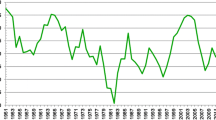Abstract
A DEA framework is used to examine changes in administrative employment in U.S. manufacturing industries between 1983 and 1989, using data collected by the U.S. Department of Labor. Among other findings, the analysis suggests that production technology is an important factor in explaining inter-industry differences in administrative staffing. In addition, "best practice" staffing efficiencies for Batch industries are shown to hold a distinct (and statistically significant) advantage over that for Line industries. On related issues, this research uncovers no evidence of the "dramatic decreases" in overhead staffing that were suggested in the popular business press during this time period. Clear structural differences in administrative staffing intensities, however, are noted with respect to manufacturing production technology. In their usage of overhead staff, Batch industries tend to be more "professional-worker" intensive, while Line industries are relatively more "non-professional-worker" intensive. These patterns hold up over time and are statistically con-firmed in an analysis of DEA "cones".
Similar content being viewed by others
References
D. Adolphson, G. Cornia and L. Walters, A unified framework for classifying DEA models, in: Operational Research '90, H. Bradley, ed., Pergamon Press, Oxford, 1991, pp. 647–657.
R. Banker, Econometric estimation and Data Envelopment Analysis, Research in Government and Nonprofit Accounting 5(1989)231–243.
R. Banker, Maximum likelihood, consistency and Data Envelopment Analysis: A statistical foundation, Management Science 39(1993)1265–1273.
J. Bishop, Is a skills shortage coming?, Workforce (Spring 1992)15–30.
P. Byrnes, The effect of ownership on efficiency: A nonparametric programming approach, Ph.D. Dissertation, Southern Illinois University, Carbondale, IL, 1985.
A. Charnes and W. Cooper, Auditing and accounting for program efficiency and management efficiency in not-for-profit entities, Accounting, Organizations and Society 5(1980)87–107.
A. Charnes, W.W. Cooper, A.Y. Lewin and L.M. Seiford, Data Envelopment Analysis: Theory, Methodology, and Applications, Kluwer Academic, Boston, 1994.
A. Charnes, W. Cooper and E. Rhodes, Measuring the efficiency of Decision Making Units, European Journal of Operational Research 2(1978)429–444.
J. Child, Parkinson's progress: Accounting for the number of specialists in organizations, Administrative Science Quarterly 18(1973)328–356.
R. Färe, S. Grosskopf, B. Lindgren and P. Roos, Productivity developments in Swedish hospitals: A Malmquist output index approach, in: Data Envelopment Analysis, Theory, Methodology, and Applications, A. Charnes, W. Cooper, A. Lewin and L. Seiford, eds., Kluwer Academic, Boston, 1994.
R. Färe, S. Grosskopf, M. Norris and Z. Zhongyang, Productivity growth, technical progress, and efficiency change in industrialized countries, American Economic Review 84(1994)66–83.
J.H. Freeman, Environment, technology, and administrative intensity of manufacturing organizations, American Sociological Review 38(1973)750–763.
R.H. Hayes and S.W. Wheelwright, Restoring Our Competitive Edge, Wiley, New York, 1984.
B.P. Indik, The relationship between organization size and supervision ratio, Administrative Science Quarterly 9(1964)301–312.
W.B. Johnston and A.E. Packer, Workforce 2000: Work and Workers for the 21st Century, Hudson Institute, Indianapolis, 1987.
W. Leontief and F. Duchin, The Future Impact of Automation on Workers, Oxford University Press, Oxford, 1986.
S. Melman, The Rise of Administrative Overhead in the Manufacturing Industries of the United States 1899–1947, Oxford University Press, Oxford, 1951.
D. Miller, Configurations of strategy and structure: Towards a synthesis, Strategic Management Journal 7(1986)233–249.
H. Mintzberg, The Structuring of Organizations, Prentice-Hall, Englewood Cliffs, NJ, 1979.
C.N. Parkinson, Parkinson's Law or the Pursuit of Progress, Murray, London, 1958.
C. Perrow, A framework for the comparative analysis of organizations, American Sociological Review 32(1967)195–208.
L. Pondy, The effects of size, complexity and ownership on administrative intensity, Administrative Science Quarterly 14(1969)57–60.
D.S. Pugh, D.J. Hickson, C.R. Hinings and C. Turner, The context of organization structures, Administrative Science Quarterly 14(1968)91–115.
W. Rushing, The effects of industry size and division of labor on administration, Administrative Science Quarterly 12(1967)273–295.
L. Seiford and R. Thrall, Recent developments in DEA: The mathematical programming approach to frontier analysis, Journal of Econometrics 46(1990)7–38.
S. Siegel, Nonparametric Statistics for the Behavioral Sciences, McGraw-Hill, New York, 1956.
J.D. Thompson, Organizations in Action, McGraw-Hill, New York, 1967.
U.S. Department of Labor, BLS Economic Growth Model System Used for Projections to 1990, Bulletin 212, U.S. Government Printing Office, Washington, DC, 1982.
U.S. Department of Labor, Bureau of Labor Statistics, Occupational Employment in Manufacturing Industries, Bulletin 2312, U.S. Government Printing Office, Washington, DC, 1988.
U.S. Office of Management and Budget, Standard Industrial Classification Manual, 1987, U.S. Government Printing Office, Washington, DC, 1987.
P.T. Ward, A.L. Betz and D.J. Bickford, Overhead surgery or media hyperbole? An examination of manufacturing employment structure in high and low tech industries, 1983 and 1989, Journal of High Technology Management Research 4(1993)95–110.
P.T. Ward, P.D. Berger, J.G. Miller and S.R. Rosenthal, Manufacturing process technology and support staff composition: An empirical view of industry evidence, Production and Operation Management 1(1992)5–21.
P. Ward and J. Miller, An empirical examination of predominant process technologies in manufacturing industries, Working Paper WPS 91-13, College of Business, The Ohio State University, 1991.
J. Woodward, Industrial Organization: Theory and Practice, Oxford University Press, Oxford, 1965.
Rights and permissions
About this article
Cite this article
Ward, P.T., Storbeck, J.E., Mangum, S.L. et al. An analysis of staffing efficiency in U.S. manufacturing: 1983 and 1989. Annals of Operations Research 73, 67–89 (1997). https://doi.org/10.1023/A:1018901916907
Issue Date:
DOI: https://doi.org/10.1023/A:1018901916907




